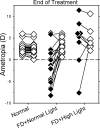Protective effects of high ambient lighting on the development of form-deprivation myopia in rhesus monkeys
- PMID: 22169102
- PMCID: PMC3292375
- DOI: 10.1167/iovs.11-8652
Protective effects of high ambient lighting on the development of form-deprivation myopia in rhesus monkeys
Abstract
Purpose: Time spent outdoors reduces the likelihood that children will develop myopia, possibly because light levels are much higher outdoors than indoors. To test this hypothesis, the effects of high ambient lighting on vision-induced myopia in monkeys were determined.
Methods: Monocular form deprivation was imposed on eight infant rhesus monkeys. Throughout the rearing period (23 ± 2 to 132 ± 8 days), auxiliary lighting increased the cage-level illuminance from normal lighting levels (15-630 lux) to ∼25,000 lux for 6 hours during the middle of the daily 12-hour light cycle. Refractive development and axial dimensions were assessed by retinoscopy and ultrasonography, respectively. Comparison data were obtained in previous studies from 18 monocularly form-deprived and 32 normal monkeys reared under ordinary laboratory lighting.
Results: Form deprivation produced axial myopia in 16 of 18 normal-light-reared monkeys. In contrast, only 2 of the 8 high-light-reared monkeys developed myopic anisometropias, and in 6 of these monkeys, the form-deprived eyes were more hyperopic than their fellow eyes. The treated eyes of the high-light-reared monkeys were more hyperopic than the form-deprived eyes of the normal-light-reared monkeys. In addition, both eyes of the high-light-reared monkeys were more hyperopic than those of normal monkeys.
Conclusions: High ambient lighting retards the development of form-deprivation myopia in monkeys. These results are in agreement with the hypothesis that the protective effects of outdoor activities against myopia in children are due to exposure to the higher light levels encountered outdoors. It is possible that therapeutic protection against myopia can be achieved by manipulating indoor lighting levels.
Figures






References
-
- Wallman J, Winawer J. Homeostasis of eye growth and the question of myopia. Neuron. 2004;43:447–468 - PubMed
-
- Smith EL, III, Environmentally induced refractive errors in animals, In: Rosenfield M, Gilmartin B, eds. Myopia and Nearwork. Oxford, UK: Butterworth-Heinemann; 1998:57–90
-
- Hung L-F, Crawford MLJ, Smith EL., III Spectacle lenses alter eye growth and the refractive status of young monkeys. Nat Med. 1995;1:761–765 - PubMed
-
- Schaeffel F, Glasser A, Howland HC. Accommodation, refractive error and eye growth in chickens. Vision Res. 1988;28:639–657 - PubMed
Publication types
MeSH terms
Grants and funding
LinkOut - more resources
Full Text Sources
Other Literature Sources

